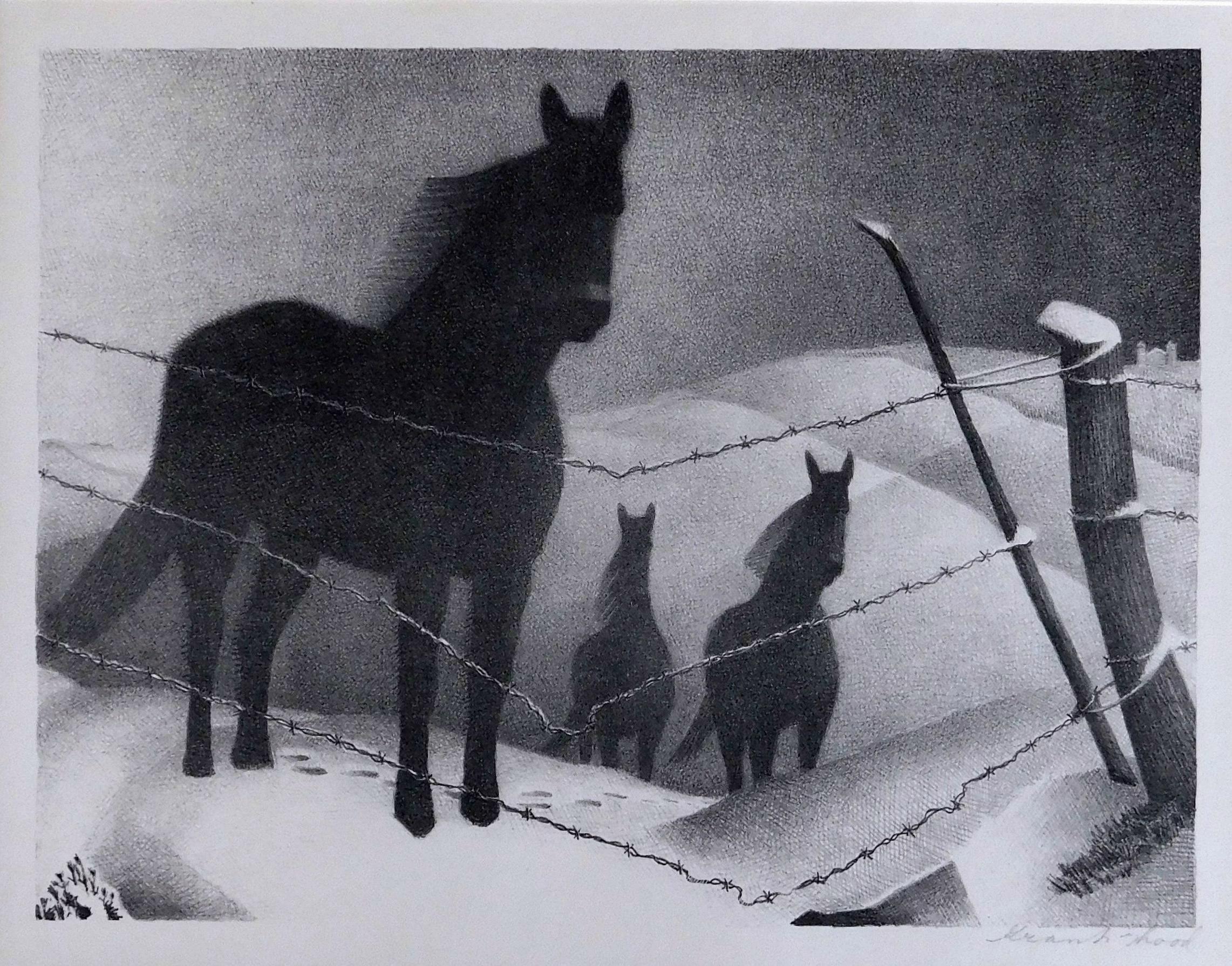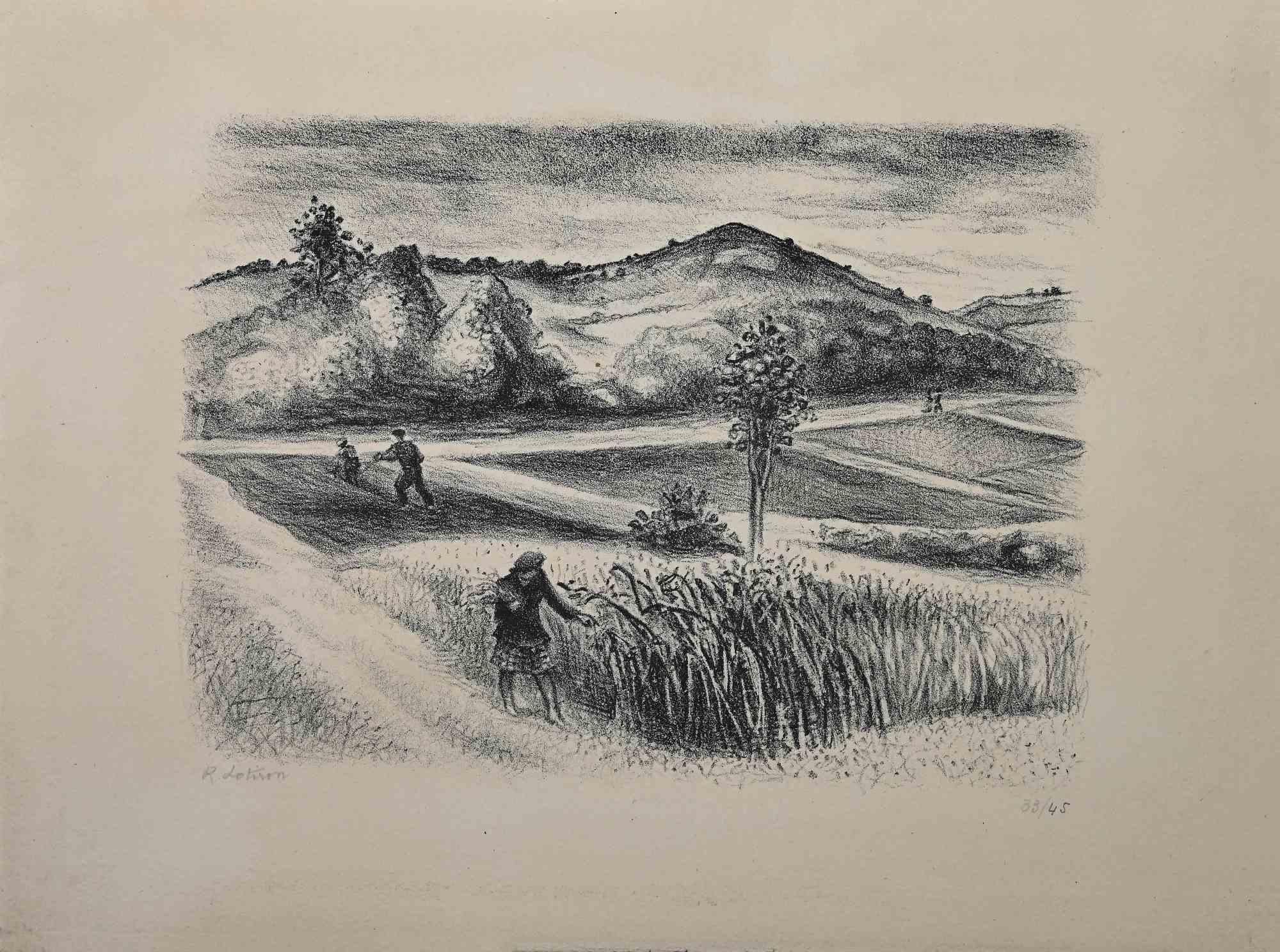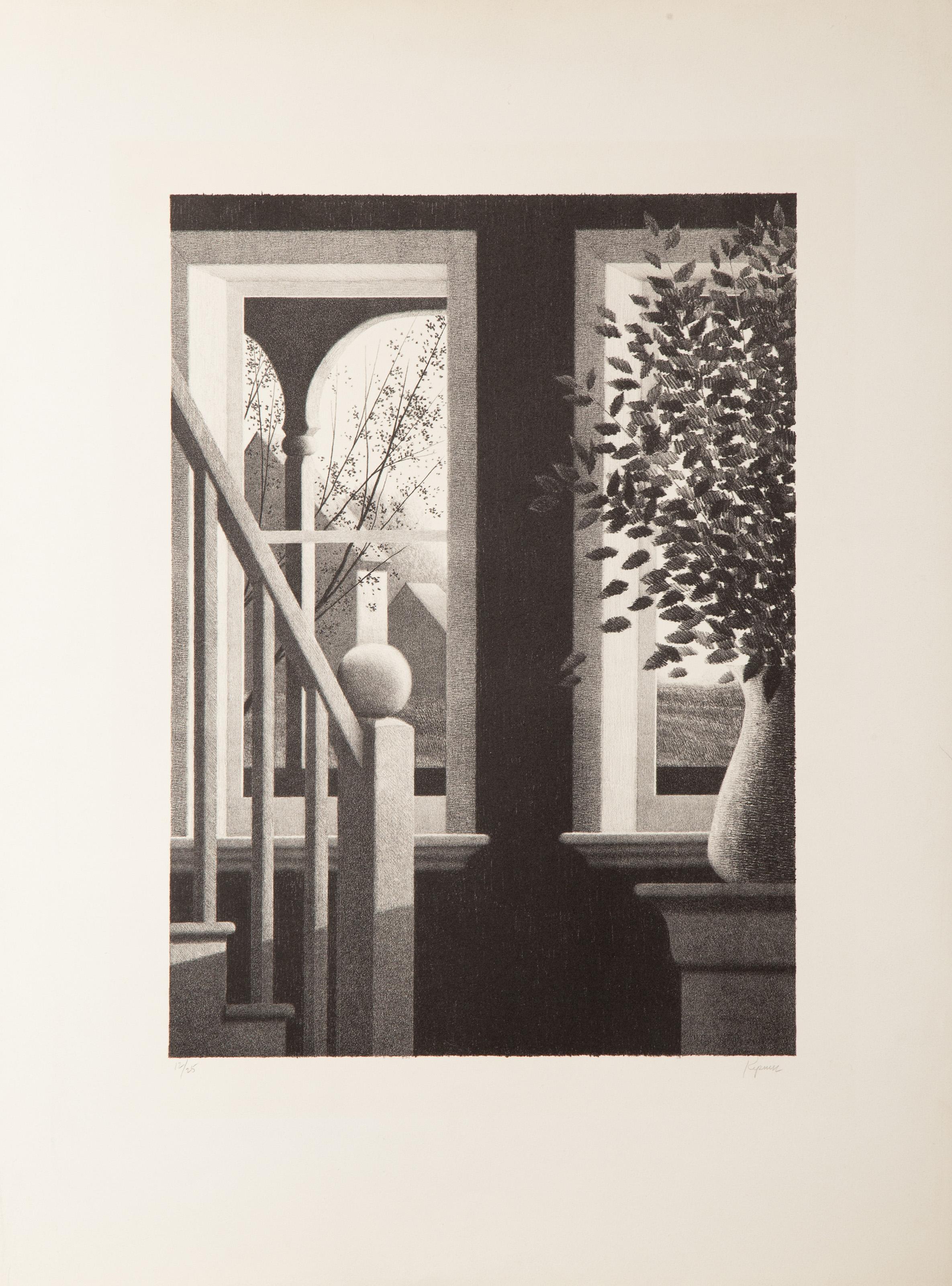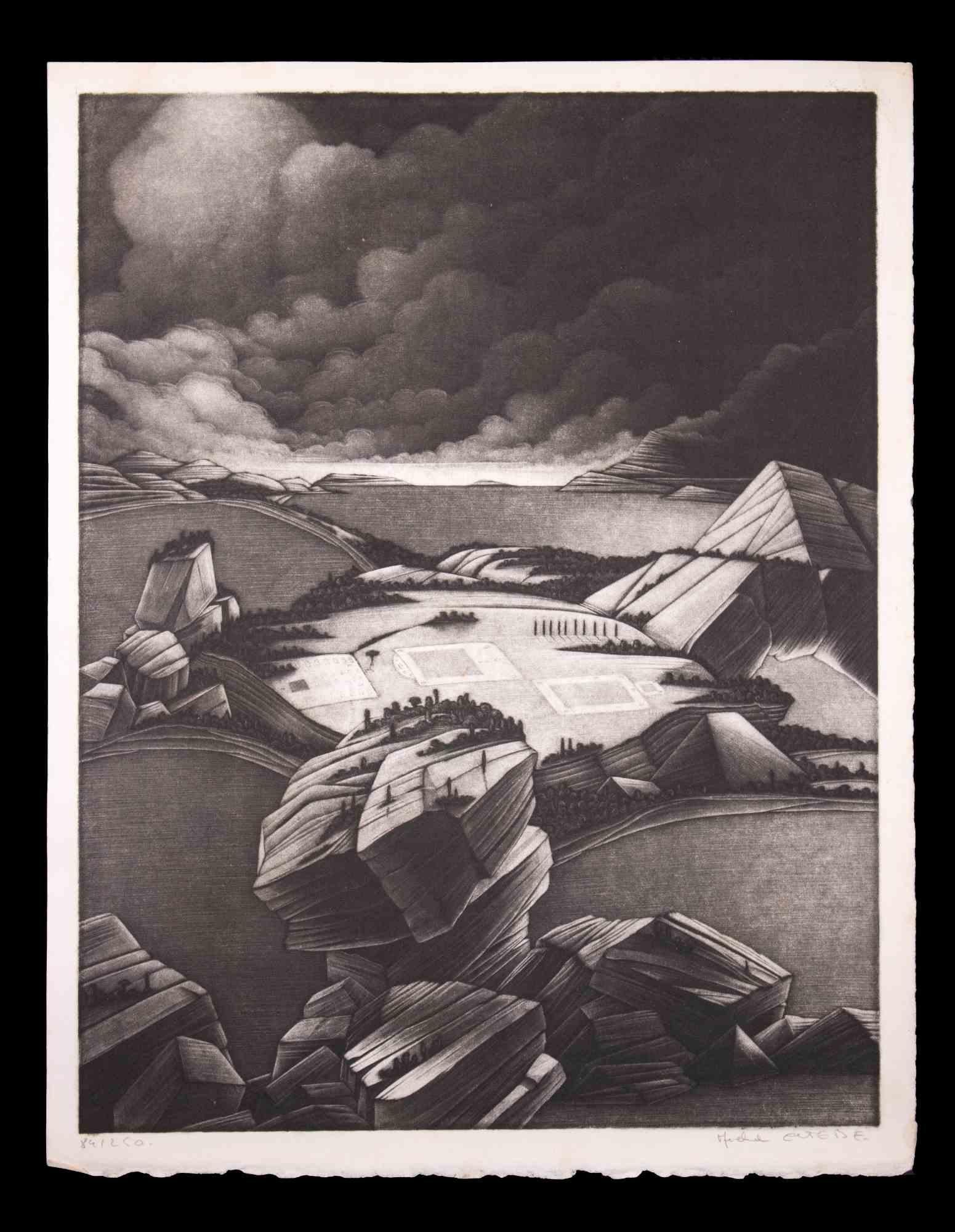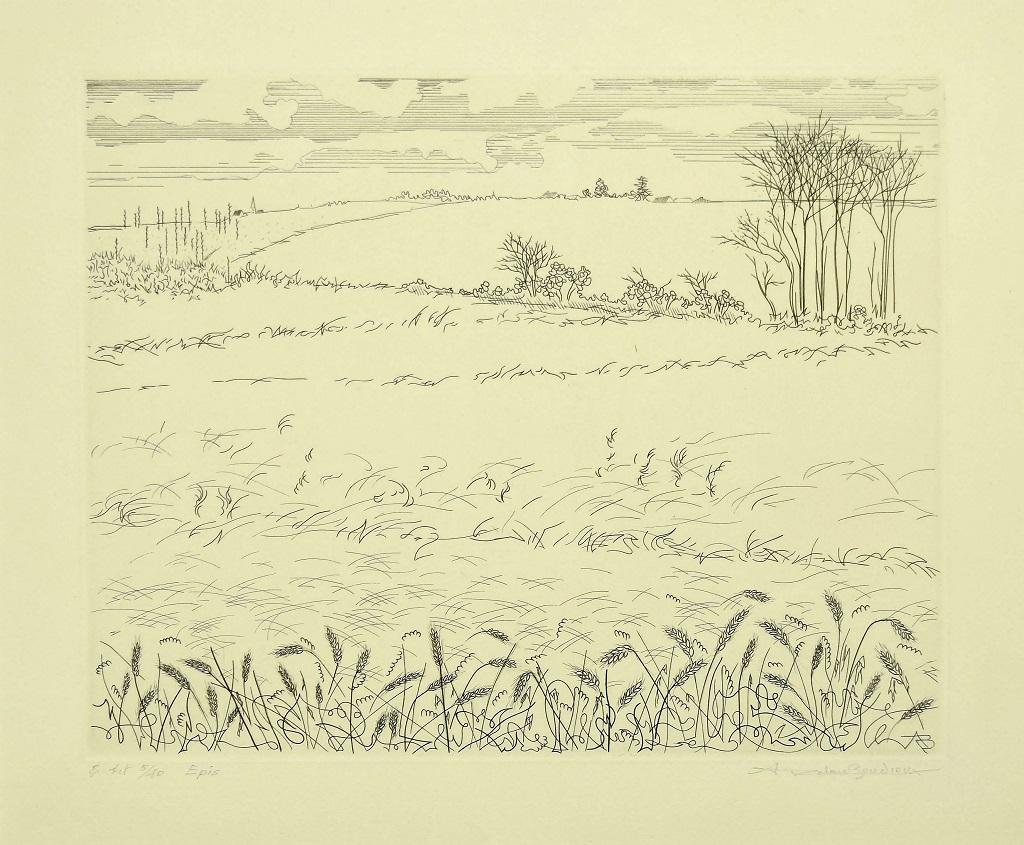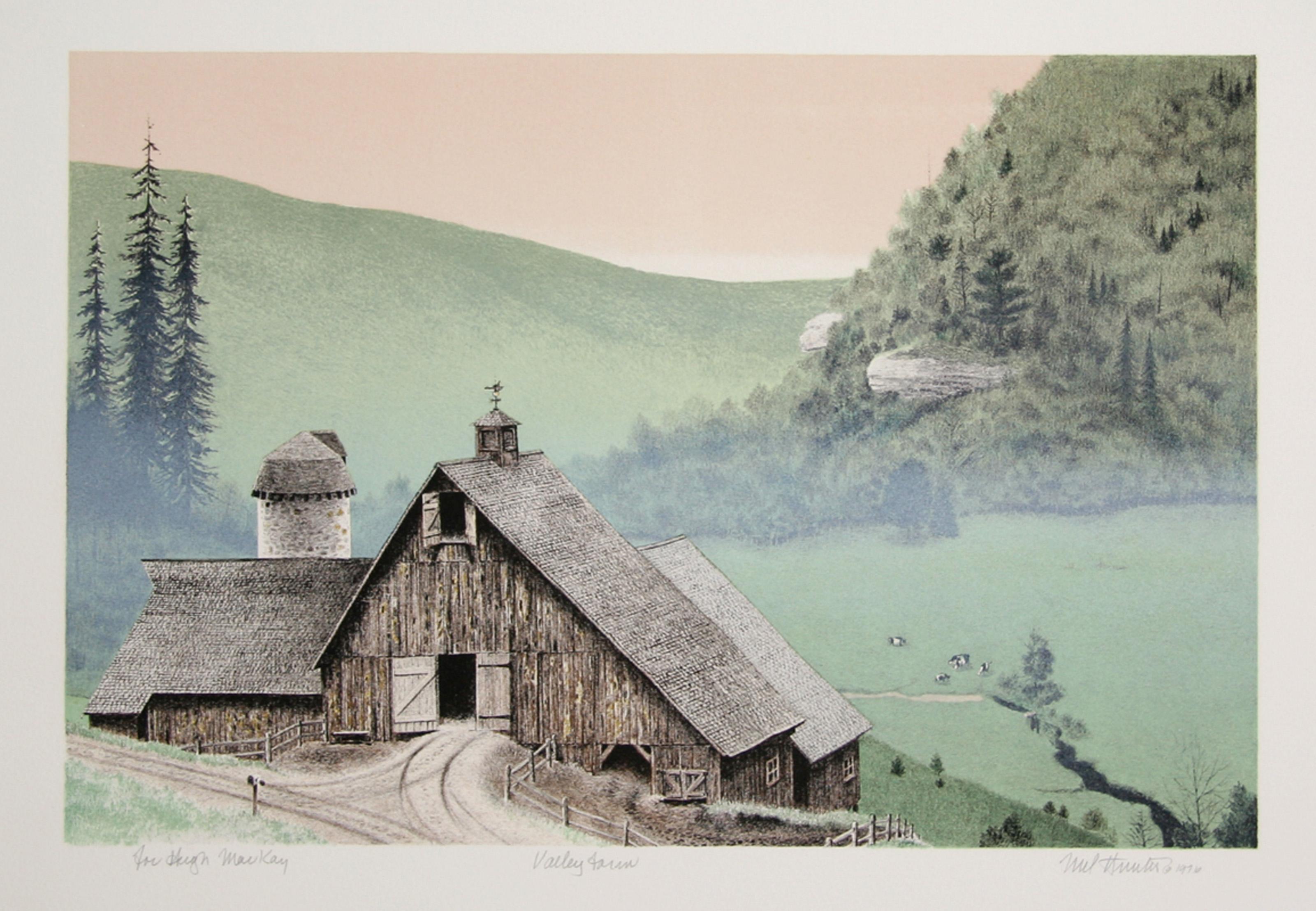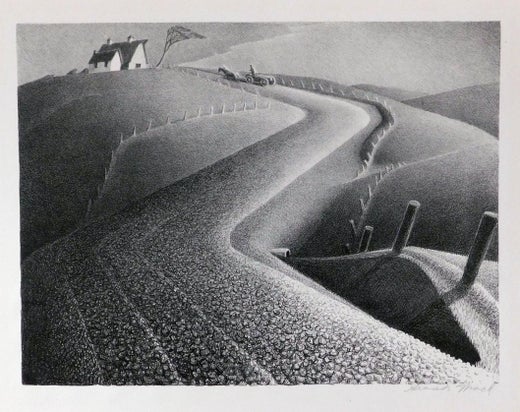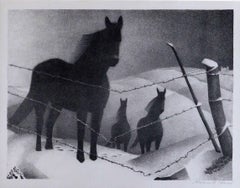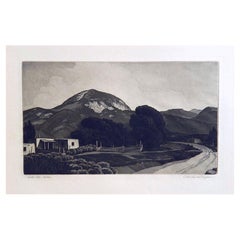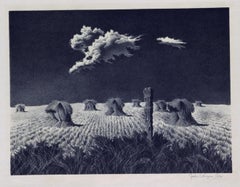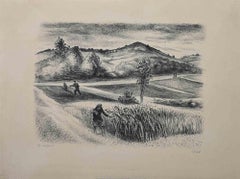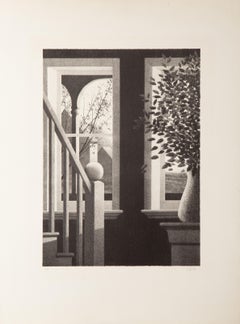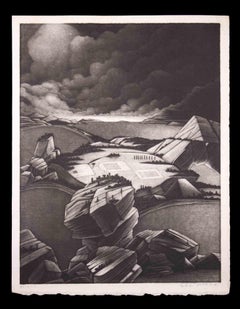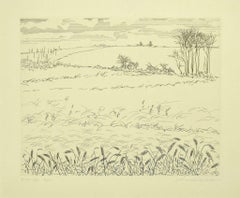Items Similar to Grant Wood Original Stone Lithograph - March
Want more images or videos?
Request additional images or videos from the seller
1 of 12
Grant WoodGrant Wood Original Stone Lithograph - March1941
1941
$9,000
£6,827.95
€7,828.64
CA$12,821.04
A$13,913.98
CHF 7,320.94
MX$169,055.23
NOK 91,656.78
SEK 86,303.20
DKK 58,452.92
About the Item
Original pencil signed Grant Wood lithograph, "March," created 1941 by the painter of "American Gothic," Grant Wood, who is a major American regionalist along with Thomas Hart Benton. The edition size is 250.
The work was created in 1939 and published in 1941 by Associated American Artists, New York. It is hand signed in pencil lower right "Grant Wood".
The condition is fine, a rich, crisp impression with full margins and deckle edges.
It is unframed and matted with an acid free archival 2-ply mat.
In excellent condition and a very nice example of Wood's work.
Title: March
Artist/Maker: Grant Wood (American, 1892–1942)
Date Created: 1941
Medium: Lithograph on paper
Image size: 9 x 11 7/8
Paper size: 12 x 16 1/8
Mat size: 16 x 20
One of the major American Regionalist painters along with Thomas Hart Benton and John Steuart Curry, Grant Wood was born in Anamosa, Iowa, and spent his childhood in Cedar Rapids. Unlike Curry and Benton, he never moved East but remained in the Midwest where he found inspiration for his paintings of prosperous farms and people reflecting idealized American values.
Wood attended the Minneapolis School of Design and Handicraft for two summers and Normal Art School as a student of Ernest Batchelder. He had brief periods of study at Iowa State University and the Art Institute of Chicago from 1913 to 1916. After World War I, he taught high school art in Cedar Rapids.
Asserting that he “had to go to France to appreciate Iowa,” he took several trips abroad, and in 1923 enrolled in the Academie Julian in Paris. However, he determined to make his life in Iowa because “all the really good ideas I’d ever had came to me while I was milking a cow.”
In 1932, he was co-founder of the Stone City Art Colony and Art School. He was director of the Public Works Art Project in Iowa as well as an Associate Professor of Fine Arts at the University of Iowa.
In 1928, Wood’s work changed when he traveled to Munich to oversee the making of a stained-glass window for the Cedar Rapids Veterans Memorial Building commissioned by the Daughters of the American Revolution. Seeing the severe, austere new style of painting in Germany combined with work from the late Gothic period, he developed a unique new style of his own that treated mid-western subjects with Gothic overtones, satire, and caricature, such as his 1930 painting, American Gothic.
- Creator:Grant Wood (1891 - 1942, American)
- Creation Year:1941
- Dimensions:Height: 16 in (40.64 cm)Width: 20 in (50.8 cm)Depth: 0.07 in (1.78 mm)
- Medium:
- Period:
- Condition:
- Gallery Location:Phoenix, AZ
- Reference Number:1stDibs: LU2749215882112
Grant Wood
One of the major American Regionalist painters along with Thomas Hart Benton and John Steuart Curry, Grant Wood was born in Anamosa, Iowa, and spent his childhood in Cedar Rapids. Unlike Curry and Benton, he never moved East but remained in the Middle West where he found inspiration for his paintings of prosperous farms and people reflecting idealized American values. However, his work was set apart from many regionalists in that provoked both laughter and social indignation. A good example Daughters of Revolution, 1932, depicting the aloof smugness of women who regarded themselves as emblematic of the country's founding values This painting was a retaliation by Wood against DAR members who had criticized him for completing their window in Germany instead of America. Much of his satire was good natured and humorous. For two summers, Wood attended the Minneapolis School of Design and Handicraft and Normal Art as a student of Ernest Batchelder, and he had brief times of study at Iowa State University and the Art Institute of Chicago from 1913 to 1916. After World War I, he taught high school art in Cedar Rapids. Asserting that he "had to go to France to appreciate Iowa," he had several trips abroad, and in 1923 enrolled in the Academie Julian in Paris, but he determined to make his life in Iowa because "all the really good ideas I'd ever had came to me while I was milking a cow." In 1932, he was co-founder of the Stone City Art Colony and Art School and he became director of the Public Works Art Project in Iowa. He was also an Associate Professor of Fine Arts at the University of Iowa. His work can be divided into two periods, the first being views of Cedar Rapids, other landscapes including scenes of Europe, and a few portraits. However, in 1928, his work changed when he traveled to Munich to oversee the making of a stained-glass window for the Cedar Rapids Veterans Memorial Building commissioned by the Daughters of the American Revolution. Seeing the severe, austere new style of painting in Germany combined with work from the late Gothic period, he developed a unique new style of his own that treated mid-western subjects with Gothic overtones, satire, and caricature. In 1930, he produced his first major landscape painting, Stone City, that had exaggerated perspective and unique naive treatment. From that time, his paintings had a simple innocence and fantasy that transported the viewer into another world, often that of a child. He also did many murals and a few lithographs, completing nineteen between 1937 and 1942, the year he died of cancer at age 50 in Iowa City. Sources include:
Matthew Baigell, Dictionary of American Art
Michael David Zellman, 300 Years of American Art
About the Seller
5.0
Gold Seller
Premium sellers maintaining a 4.3+ rating and 24-hour response times
1stDibs seller since 2024
39 sales on 1stDibs
Typical response time: 1 hour
- ShippingRetrieving quote...Shipping from: Phoenix, AZ
- Return Policy
Authenticity Guarantee
In the unlikely event there’s an issue with an item’s authenticity, contact us within 1 year for a full refund. DetailsMoney-Back Guarantee
If your item is not as described, is damaged in transit, or does not arrive, contact us within 7 days for a full refund. Details24-Hour Cancellation
You have a 24-hour grace period in which to reconsider your purchase, with no questions asked.Vetted Professional Sellers
Our world-class sellers must adhere to strict standards for service and quality, maintaining the integrity of our listings.Price-Match Guarantee
If you find that a seller listed the same item for a lower price elsewhere, we’ll match it.Trusted Global Delivery
Our best-in-class carrier network provides specialized shipping options worldwide, including custom delivery.More From This Seller
View AllGrant Wood Original Pencil Signed Lithograph, 1940 - February
By Grant Wood
Located in Phoenix, AZ
Original pencil signed Grant Wood lithograph, "February," created 1940.
A fine impression and one of the most important of the 19 lithographs created by the painter of "American Goth...
Category
1940s Landscape Prints
Materials
Paper, Lithograph
Charles Capps Pencil Signed Original Etching, 1947, "Into the Hills"
Located in Phoenix, AZ
Charles capps etching and aquatint.
Unframed, Archivally matted in a 16 x 20 two ply.
Titled: "Into the Hills." pencil signed lower right.
A Prairie Pri...
Category
Mid-20th Century Landscape Prints
Materials
Paper
John Rogers Cox Original AAA Lithograph. “Wheat Shocks”
By John Rogers Cox
Located in Phoenix, AZ
Original pencil signed stone lithograph by AAA artist John Rogers Cox (1915-1990)
This wonderful Regionalist image measures 8 3/4"h x 11 3/4"w.
Paper size is 12 x 16. The work presen...
Category
1950s Landscape Prints
Materials
Lithograph
Thomas Hart Benton Original Lithograph, 1939 - "Shallow Creek"
By Thomas Hart Benton
Located in Phoenix, AZ
Original stone lithograph by well-known Regionalist Thomas Hart Benton (1889-1975).
Titled: "Shallow Creek.” The print has full margins and is in excellent condition.
AAA print creat...
Category
1930s Landscape Prints
Materials
Paper
Benton Spruance Pencil Signed Lithograph - Shells for the Living
Located in Phoenix, AZ
Benton Spruance, Pennsylvania artist, original lithograph, 1933.
Titled “Shells for the Living.” The edition size is 28.
The image measures 15 7/16"h x 7 7/16"w. Printed by Cuno.
Th...
Category
Mid-20th Century More Prints
Materials
Paper, Lithograph
Original Woodcut - Sheep Ranch
By Ina Annette
Located in Phoenix, AZ
Excellent Woodcut print by Oklahoma/New Mexico artist Ina Annette (1901-1990).
The image measures 10 ½ x 13 ½ inches. The work rests in a 17 1/4 x 20 1/4 inch museum mat.
The print i...
Category
Mid-20th Century Landscape Prints
Materials
Paper, Woodcut
You May Also Like
Landscape - Original Lithograph by Robert Lotiron - Mid-20th Century
By Robert Lotiron
Located in Roma, IT
Landscape is an original Lithograph on paper realized by Robert Lotiron in the Mid-20th Century.
Good Conditions.
Hand-signed.
Numbered. Edition, 33/45.
The artwork represents a ...
Category
Mid-20th Century Figurative Prints
Materials
Lithograph
Hillside Place, Modern Lithograph by Robert Kipniss
By Robert Kipniss
Located in Long Island City, NY
Robert Kipness was an American painter and printmaker who’s work focused on forms and a pronounced moodiness. This print is signed, numbered, dated, and...
Category
1980s American Impressionist Still-life Prints
Materials
Lithograph
Landscape - Original Lithograph by Michel Estèbe - 1980s
By Michel Estebe
Located in Roma, IT
Landscape is an Original Lithograph realized by Michel Estèbe. Hand signed on the lower right margin.
Good conditions.
Michel Estèbe is a french artist born in Talence. He studied ...
Category
1980s Contemporary Figurative Prints
Materials
Lithograph
Epis- Original Etching by Andre Roland Brudieux - Mid 20th Century
By André Roland Brudieux
Located in Roma, IT
Epis is an original Contemporary artwork realized by the artist André Roland Brudieux (1921-1999) in the mid 20th Century.
Original B/W Etchin...
Category
Mid-20th Century Modern Landscape Prints
Materials
Etching
Valley Farm, American Realist Lithograph by Mel Hunter
By Mel Hunter
Located in Long Island City, NY
Mel Hunter, American (1927 - 2004) - Valley Farm, Year: 1976, Medium: Lithograph, signed in pencil, Size: 15 x 20 in. (38.1 x 50.8 cm)
Category
1970s American Realist Landscape Prints
Materials
Lithograph
Landscape - Etching on Paper - 20th Century
Located in Roma, IT
Landscape is an original etching on paper realized by an unknown artist of the XX century.
The State of preservation is very good with some small stain on the margins.
Sheet dimen...
Category
20th Century Modern Figurative Prints
Materials
Etching
